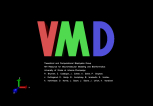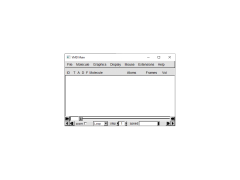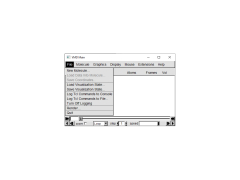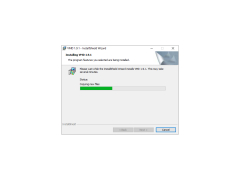
VMD
by University of Illinois
VMD is a molecular visualization and analysis program for displaying, animating, and analyzing large biomolecular systems using 3D graphics and built-in scripting.
Operating system: Windows
Publisher: University of Illinois
Antivirus check: passed
VMD (Visual Molecular Dynamics) is an interactive molecular visualization and analysis program designed for biomolecules. It runs on a variety of platforms including Windows, Mac OS X, and Linux. VMD provides a wide range of features for the analysis of biomolecular systems, including:
1. Molecular Dynamics Simulations: VMD supports an extensive range of atom-based and coarse-grained molecular dynamics simulations, including those using CHARMM, AMBER, and NAMD. It is also capable of creating trajectory files in various formats, including the widely used DCD (dynamic coordinate) file format.
2. Graphical User Interface: VMD has a sophisticated graphical user interface (GUI) which is highly customizable and intuitive to use. The GUI makes it easy to navigate complex molecular dynamics simulations, visualize them in 3D, and analyze the data.
3. Molecular Visualization: VMD provides a range of powerful visualization tools, including the ability to create high-resolution images and videos of molecular structures and dynamic processes.
4. Analysis Tools: VMD includes a set of analysis tools for molecular dynamics simulations, including the ability to calculate the free energy of proteins and ligands, the ability to analyze electrostatic potentials, and the ability to measure distances and angles between atoms.
5. Molecular Manipulation: VMD includes a set of tools for manipulating molecules, including the ability to rotate, translate, and scale molecules, as well as the ability to add/remove atoms and bonds.
6. Molecular Design: VMD includes a set of tools for designing molecules, including the ability to create and optimize protein structures, and the ability to perform ligand-based virtual screening.
7. Molecular Interaction Networks: VMD includes a set of tools for creating and visualizing molecular interaction networks, including the ability to view hydrogen bonds, electrostatic interactions, and van der Waals interactions.
8. Molecular Scripting: VMD includes an integrated scripting language, allowing users to write custom scripts to automate tasks and extend the functionality of VMD.
9. Web Services: VMD includes a set of web service APIs, allowing users to interact with VMD from remote locations and access the VMD program from the web.
1. Molecular Dynamics Simulations: VMD supports an extensive range of atom-based and coarse-grained molecular dynamics simulations, including those using CHARMM, AMBER, and NAMD. It is also capable of creating trajectory files in various formats, including the widely used DCD (dynamic coordinate) file format.
2. Graphical User Interface: VMD has a sophisticated graphical user interface (GUI) which is highly customizable and intuitive to use. The GUI makes it easy to navigate complex molecular dynamics simulations, visualize them in 3D, and analyze the data.
3. Molecular Visualization: VMD provides a range of powerful visualization tools, including the ability to create high-resolution images and videos of molecular structures and dynamic processes.
4. Analysis Tools: VMD includes a set of analysis tools for molecular dynamics simulations, including the ability to calculate the free energy of proteins and ligands, the ability to analyze electrostatic potentials, and the ability to measure distances and angles between atoms.
5. Molecular Manipulation: VMD includes a set of tools for manipulating molecules, including the ability to rotate, translate, and scale molecules, as well as the ability to add/remove atoms and bonds.
6. Molecular Design: VMD includes a set of tools for designing molecules, including the ability to create and optimize protein structures, and the ability to perform ligand-based virtual screening.
7. Molecular Interaction Networks: VMD includes a set of tools for creating and visualizing molecular interaction networks, including the ability to view hydrogen bonds, electrostatic interactions, and van der Waals interactions.
8. Molecular Scripting: VMD includes an integrated scripting language, allowing users to write custom scripts to automate tasks and extend the functionality of VMD.
9. Web Services: VMD includes a set of web service APIs, allowing users to interact with VMD from remote locations and access the VMD program from the web.
VMD enables the visualization of molecular structures, dynamic processes, and their physical properties in detail.
The minimum technical requirements for the VMD software to run properly are:
• Operating System: Windows 7, 8, 10 (64-bit); Mac OS X 10.10 or later; Linux kernel 3.2 or later
• Processor: Intel Core2 Duo or AMD Athlon 64 X2
• Memory: 4GB RAM
• Hard Disk: 10GB of free disk space
• Graphics: OpenGL 3.2-capable graphics card with at least 256MB of VRAM
• Display: 1280x1024 resolution or higher
• Operating System: Windows 7, 8, 10 (64-bit); Mac OS X 10.10 or later; Linux kernel 3.2 or later
• Processor: Intel Core2 Duo or AMD Athlon 64 X2
• Memory: 4GB RAM
• Hard Disk: 10GB of free disk space
• Graphics: OpenGL 3.2-capable graphics card with at least 256MB of VRAM
• Display: 1280x1024 resolution or higher
PROS
Allows visualization of large biomolecular systems with high-quality graphics.
Supports a wide range of molecular formats and simulation types.
Open-source software enables customizable features and free usage.
Supports a wide range of molecular formats and simulation types.
Open-source software enables customizable features and free usage.
CONS
Can be complex for beginners to understand and navigate.
Certain features lack in-depth explanation or user guidance.
Technical support could be more responsive and helpful.
Certain features lack in-depth explanation or user guidance.
Technical support could be more responsive and helpful.
Rory Scoular
VMD is a powerful molecular visualization and analysis program. I have used it for molecular dynamics simulations and analyzing the structures of proteins, DNA and RNA molecules. It is quite easy to learn and use, with a user-friendly interface. The software includes a variety of features such as movie making, animation, scripting, and a wide range of visualization capabilities.
The graphics rendered by VMD are high quality, which is important for making scientific figures. It also supports a wide range of file types, including PDB, MOL2, GRO, and DCD. Overall, VMD is a great tool for visualizing and analyzing molecular structures.







